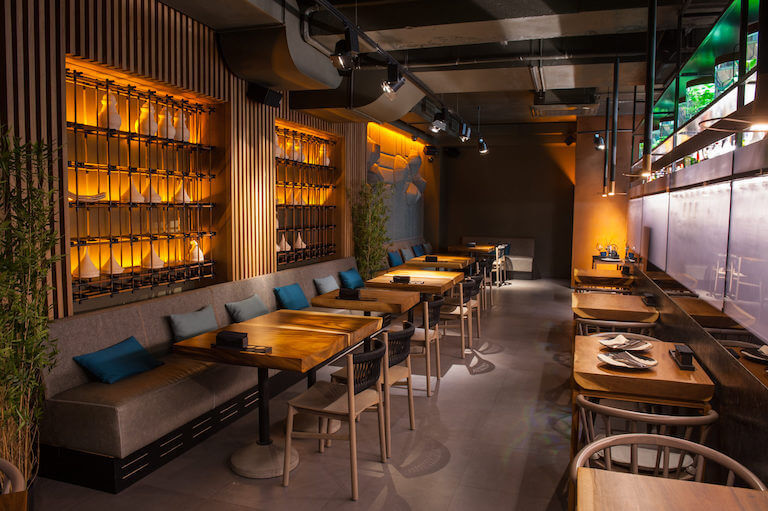Best Asian Restaurant Islamabad: Experience Flavors from Throughout Asia
Best Asian Restaurant Islamabad: Experience Flavors from Throughout Asia
Blog Article
Savor Genuine Oriental Food With a Pan-Asian Spin for a Cooking Experience
Beginning on a culinary journey via genuine Oriental cuisine, improved with a Pan-Asian spin, uses a special possibility to explore the rich tapestry of tastes that define the region's diverse cooking customs. This experience invites you to appreciate the splendid equilibrium of tastes-- wonderful, salted, spicy, and sour-- harmonized by fragrant natural herbs and seasonings. Imagine the innovative blend of Thai curry and ramen or the unanticipated pleasure of sushi burritos. As you ponder these tempting recipes, take into consideration the social narratives and historic influences that shape them, each bite offering a story waiting to be discovered.

Checking Out Pan-Asian Flavors
In the realm of international gastronomy, Pan-Asian food attracts attention for its exceptional diversity and the unified interplay of flavors from numerous Asian societies. This cooking method celebrates the rich traditions and distinct ingredients found throughout the continent, developing a tapestry of tastes that is both satisfying and interesting. Secret to Pan-Asian food is its capability to balance contrasting flavors-- pleasant, salted, spicy, and sour-- while highlighting the freshness and top quality of each ingredient.
From the umami-rich soy sauce of Japan to the fiery chili peppers of Thailand, Pan-Asian food uses an extensive scheme of tastes. These components are typically integrated in creative ways, improving meals with layers of complexity. For example, the use of fragrant natural herbs such as lemongrass and cilantro, usual in Vietnamese and Thai food, includes a revitalizing illumination to dishes, while the unification of coconut milk delivers a luscious, abundant structure.
The focus on fresh produce and fragrant flavors guarantees that each meal is not just a feast for the taste however also for the detects. Pan-Asian cuisine invites diners to start a cooking journey, discovering the vast and differed landscapes of Oriental gastronomy with every bite.
Blend Recipes to Try
While Pan-Asian cuisine is celebrated for its conventional flavors, the modern culinary landscape is increasingly welcoming fusion meals that mix these classic elements with impacts from various other regions. This ingenious strategy not just honors the rich heritage of Asian culinary arts but also introduces unique preference experiences that interest modern tastes.
A prime instance of such a blend recipe is the Korean-Mexican taco, where seasoned bulgogi beef is wrapped in a warm tortilla, topped with kimchi and a zesty gochujang-infused salsa. This combination weds the strong, mouthwatering tastes of Korea with the lively, fresh components of Mexican cuisine. Similarly, sushi burritos have acquired popularity, amalgamating the fragile virtuosity of Japanese sushi with the hearty, hand-held comfort of a burrito, often including fusion ingredients like tempura shrimp and avocado with a drizzle of wasabi mayo.
One more significant dish is Thai curry ramen, which infuses the luscious, fragrant seasonings of Thai curry right into the comforting broth of standard Japanese ramen, creating a harmonious blend that tantalizes the detects. These fusion recipes prolong beyond mere uniqueness; they represent a cooking discussion in between societies, urging exploration and technology in the world of Pan-Asian cuisine.
Necessary Components and Seasonings
To really value Pan-Asian cuisine, one need to comprehend the important components and spices that create its structure. This diverse culinary design attracts from an abundant tapestry of Oriental customs, employing a harmonious blend of appearances and flavors. Trick components consist of soy sauce, fish sauce, and oyster sauce, which give a full-flavored umami deepness crucial to Eastern meals. Complementary to these are rice vinegar and mirin, offering a delicate level of acidity and sweet taste.
Fragrant elements are pivotal, with garlic, ginger, and lemongrass being ubiquitous across various Pan-Asian recipes. These active ingredients give a fragrant base that enhances the complexity of tastes. Flavors such as star anise, cardamom, and cinnamon present heat and character, resembling impacts from areas like China and India.

Cooking Methods and Tips
Mastering the art of Pan-Asian cuisine requires knowledge with its distinctive food preparation techniques, each contributing to the vivid tapestry of tastes this culinary practice is celebrated for. Central to these methods is the stir-fry, a quick food preparation method that preserves the dietary integrity and vivid shades of ingredients. Making use of a frying pan, the stir-fry technique enables also heat distribution, necessary for achieving the characteristic appearance and taste equilibrium of Pan-Asian recipes.
An additional fundamental technique is steaming, especially common in Chinese cuisine. This gentle technique preserves the all-natural tastes and nutrients of active ingredients, making it ideal for fish and shellfish and veggies. Dumplings, a cherished staple, frequently gain from steaming, causing soft, delicious appearances.
Cooking, also indispensable, presents great smoky midsts to recipes such as Oriental bulgogi or Japanese yakitori (Romantic restaurants Islamabad). This technique usually entails marinating ingredients, enabling tastes to penetrate deeply prior to food preparation over an open fire or warmer
Lastly, understanding the art of stabilizing flavors-- wonderful, sour, salty, bitter, and umami-- is essential. Effectively layering these components can elevate a meal from average to amazing, providing a complicated and satisfying culinary experience that embodies the significance of Pan-Asian food.
Eating Experiences Worldwide
Around the world, Pan-Asian food provides an unequaled eating experience, commemorated for its abundant tapestry of flavors and lively presentations. This cooking phenomenon has transcended cultural limits, capturing the hearts and tastes of food lovers worldwide. In multicultural cities fresh York, London, and Sydney, Pan-Asian restaurants work as melting pots where cooking practices from Thailand, Japan, China, and beyond merge, supplying diners with an eclectic mix of recipes that highlight the region's diversity.
The international charm of Pan-Asian cuisine depends on its capability to offer both authenticity and technology. Cooks masterfully marry traditional components such as lemongrass, soy sauce, and miso with modern strategies, resulting in meals that are both refreshingly new and familiar. This blend enables restaurants to start a culinary trip that values heritage while welcoming modernity.
In addition, eating experiences are raised with attentively developed environments that show the ethos of Pan-Asian looks. From minimal Japanese-inspired interiors to dynamic Thai-themed spaces, each dining establishment uses a special atmosphere that enhances the cooking offerings. Because of this, customers are not simply taking in a meal yet partaking in a social experience, making Pan-Asian dining a genuinely worldwide sensation.
Final Thought
The exploration of Pan-Asian cuisine uses an extensive understanding of the detailed interplay of tastes and cooking customs throughout Asia. By accepting fusion dishes such as Thai curry ramen and sushi burritos, the culinary trip not only highlights the versatility of typical components however also showcases ingenious modern strategies. This gastronomic experience, enhanced by vital flavors and cooking techniques, provides an one-of-a-kind chance to appreciate the social variety and culinary virtuosity that define Pan-Asian food on an international range.
Beginning on a culinary journey via genuine Asian cuisine, improved with a Pan-Asian spin, supplies an unique possibility to check out the rich tapestry of flavors that specify the region's diverse culinary practices.In the world of global gastronomy, Pan-Asian food stands out for its exceptional diversity and the unified interaction of tastes from different Oriental cultures. Secret to Pan-Asian food is its capacity to balance contrasting flavors-- pleasant, salty, spicy, and sour-- while highlighting the quality and quality of each component.

Report this page